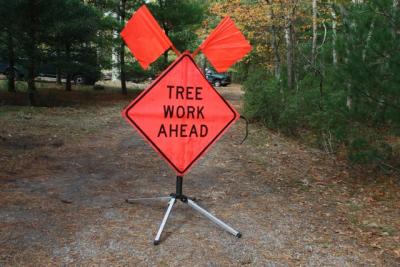Rush to Contain Beetle

A spreading infestation of southern pine beetles in Northwest Woods, East Hampton, prompted Town Supervisor Larry Cantwell to declare a state of emergency last Thursday, authorizing town employees to inspect both public and private lands and, if necessary, cut down infested trees, with the permission of the landowner.
Concerned residents — “a very high volume,” according to the town’s Department of Land Acquisition and Management — have been calling Town Hall, including many from the Northwest neighborhood, but also from other parts of town. Inspections are ongoing, Andy Drake, an environmental analyst for the town, said in an email on Tuesday, and a map showing the spread of the pine beetle outbreak is being created.
“We are doing our best to get back to everyone that calls as quickly as possible,” wrote Mr. Drake. In addition to more than 1,700 affected trees on a piece of town-owned land, about 800 trees on private property have been found infested.
Workers deployed to East Hampton by the State Department of Environmental Conservation began cutting down infested trees on the town-owned site on Tuesday. The team is expected to be at work on the outbreak for the next week.
Town workers felled an additional 20 “stage-one infested pitch pines,” Mr. Drake said, on the former Maeder property at 46 Swamp Road in East Hampton, which the town purchased using the community preservation fund.
Mr. Cantwell’s emergency declaration says that “time is of the essence to attempt to manage and stop the spread of the infestation, as town staff is observing more trees being infested on a daily basis.” Accordingly, the town has given the land management staff authority to contract with private tree care companies to cut down beetle-infested trees. The department is receiving bids from several companies, and hopes to have agreements in place for work to begin on private lands next week, said Mr. Drake.
The town board will be asked at its meeting tomorrow night to approve funding up to $180,000 to address the pine beetle crisis, Mr. Cantwell said. Of that sum, $100,000 would come from the preservation fund, which can be used for work on lands purchased and preserved through the C.P.F. program. Work on other town-owned or private lands would be paid for with an $80,000 appropriation from the town’s general fund. The initial five-day state-of-emergency period, which expired Tuesday afternoon, is to be extended.
“The goal here is for the tree to be felled flat on the ground,” and for cuts to be made in the bark to expose beetles to predators and the weather, Mr. Cantwell explained Tuesday. On average, he said, the work costs $100 per tree.
The State Department of Environmental Conservation “has advised that the infestation will continue to spread to other public and private properties that are dominated by pitch pines if not managed, posing the threat of creating an environmental catastrophe of tens of thousands of pitch pines being killed by these beetles,” according to the emergency declaration.
Native to the southeastern United States, where they have severely impacted forests, southern pine beetles have been expanding their range. Warming winter temperatures are believed to be the cause.
The beetles were first found in New York State three years ago in other areas of Suffolk County, including Long Island’s core Pine Barrens. Until now, East Hampton has been spared a serious outbreak.
“The threat of tree loss from pine beetle infestation of pitch pine forests is great where an outbreak spreads rapidly during certain times of the year,” Mr. Cantwell said last week in a release. “The adult beetle tunnels through the tree underneath the bark, killing the tree in two to four months.”
While it appears pitch pines are the trees most affected at present, there is concern, the supervisor said, about beetles spreading to white pines and other East Hampton pine forests.
Southern pine beetle populations can persist for years in low numbers, according to the D.E.C., but then explode, killing many trees, if conditions are right. Signs of an infestation include clumps of resin visible on the exterior of pine trees, holes and tunnels in the bark, and reddish-brown dead needles.
East Hampton Town had already planned to seek state funding for a pine beetle containment program that would have begun in January, but the spread of the beetles has created an “urgent need” to curtail infestations, according to Mr. Drake.
“Southern pine beetles are believed to be idle below 45 degrees Fahrenheit,” he wrote. “So, hopefully, the temperatures drop very soon and the pause button is hit on this southern pine beetle expansion.”
Property owners wanting to report an infestation or request a site inspection have been asked to contact the Department of Land Acquisition and Management at 631-324-7420. The D.E.C. website contains general information about the southern pine beetle and its impact on trees.
